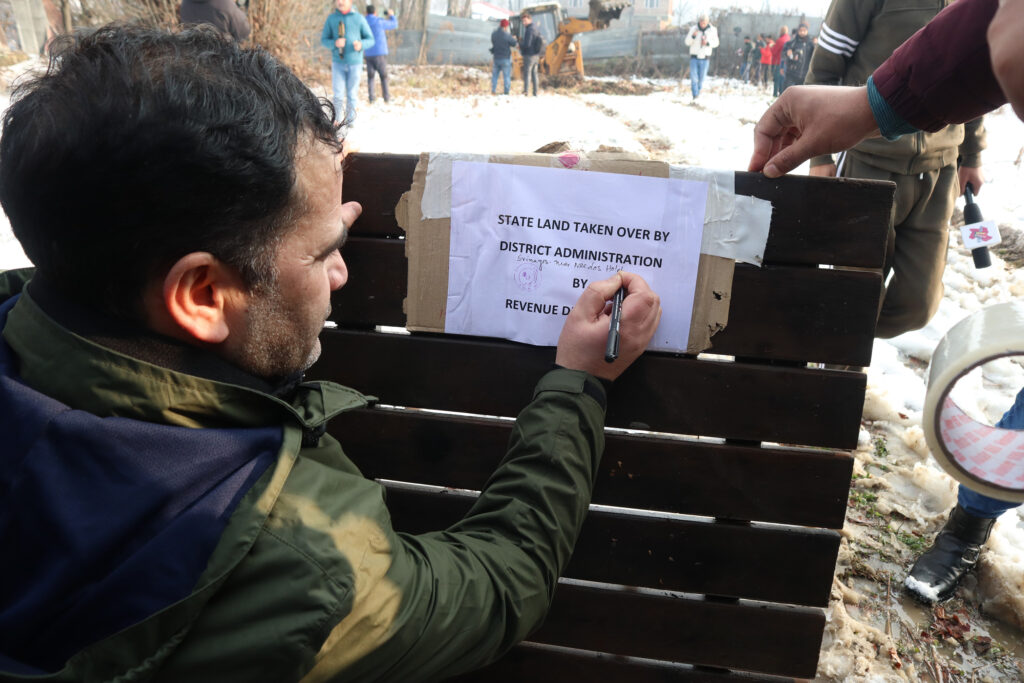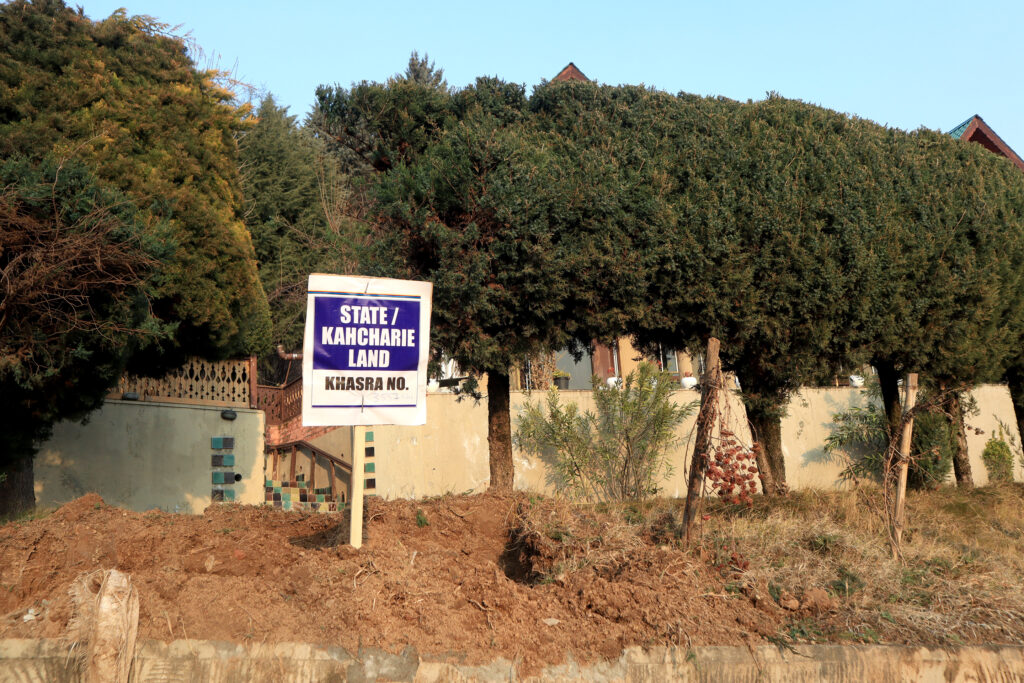By targeting land grabbers from the BJP, the J&K administration has demonstrated its resolve to take the anti-encroachment drive to its logical conclusion without political appeasement. Now, a comprehensive policy should be rolled out to protect the lives and livelihoods of ordinary people.
By Chasfeeda Shah
Even as the opposition parties continue to cry foul, the Jammu and Kashmir administration has embarked on a mission to retrieve hundreds of thousands of kanals of state, grazing, and common land that has been encroached across the union territory.
While the drive had prompted uproar in Jammu and Kashmir after some poor people were targeted by the anti-encroachment squad, Union Home Minister Amit Shah, after holding a high-level meeting with Lieutenant Governor Manoj Sinha in New Delhi in February, has issued clear verbal orders to J&K administration to ensure that no poor dweller is deprived of his home.

“During the course of his meeting with LG and senior officers, Shah said that the drive against influential and rich people who made the illegal occupation of state land their choicest pastime during the last many decades shall continue without any hiccup,” reports said.
The drive was started after a circular on January 9 by J&K’s Commissioner Secretary, Department of Revenue, Vijay Kumar Bidhuri, ordered all the 20 Deputy Commissioners to remove the encroachments from the state land, including Roshni land, Kahcharai (grazing land), and Shamilat (common land), by the end of January.
According to a government survey, 20.46 lakh kanals of state land, including grazing and common lands, have been encroached in Jammu and Kashmir which could be used for public purposes. Land encroachment is a larger reality in not just Jammu and Kashmir but across the country.
J&K has undergone land reforms since the time of the last Dogra ruler Maharaja Hari Singh. From time to time, the ownership of land has been transferred to the occupants after following due process, even as the owners continued to encroach more and more land.
“According to a government survey, 20.46 lakh kanals of state land, including grazing and common lands, have been encroached in Jammu and Kashmir which could be used for public purposes”
Land encroachment became an endemic issue after early 1990s when an armed insurgency broke out, which ushered the union territory into a state of complete lawlessness. A state of anarchy allowed people as well as land sharks in J&K to encroach land with impunity. In the meantime, conflict and population boom pushed people to move out of the villages into towns and cities where the state and other lands were literally put on sale by some revenue officials who were hand in glove with local land mafia.

In 2021, the government of then Chief Minister Dr Farooq Abdullah rolled out the J&K State Land (Vesting of Ownership to the Occupants) Act, or Roshni scheme. The government had planned to regularise the encroached land against a premium, hoping to raise Rs 25000 crore which was going to be invested in building hydropower projects in J&K.
When the scheme was finally rolled out after several modifications by the government led by Ghulam Nabi Azad in 2007, the earning came down to only Rs 76.46 crore. Out of 20.46 lakh kanals of encroached land in Jammu and Kashmir, about six lakh kanal were approved for transfer but the actual land transfer was only 3.48 lakh kanals.
“The retrieval of land owned by individuals such as Kavinder Gupta, Sofi Yousuf or any other politician demonstrates that the land grabbers, regardless of their political affiliations, are not going to be spared”
This prompted allegations of financial and political irregularities which were also pointed out by a Comptroller and Auditor General report in 2014, alleging that the premium was arbitrarily reduced to favour politicians and influential people. According to reports, more than 30 politicians from various political parties, former J&K ministers and lawmakers, top hoteliers, and other businessmen are among the beneficiaries of the Roshni Act.
In 2018, after the collapse of the PDP-BJP government, the scheme was written off and in 2020 the J&K High Court termed it as “illegal, unconstitutional, and unsustainable.”
To reclaim the Roshni and other encroached land, the administration, in the middle of January, fanned out several dozen teams of civil and police administration officials led by bulldozers which targeted the illegal structures in the union territory. In some instances, the structures were taken over by the administration.
The anti-encroachment drive triggered an uproar. A climate of anguish spread in the union territory as the visuals of land excavators tearing down allegedly illegal structures circulated on social media. The officials involved in the drive also faced resistance in some parts of the UT, including in Jammu, where three policemen were injured during a protest against the demolition of a shopping complex in Narwal which boiled down into stone pelting on the demolition team.

Protests were also held in parts of Srinagar, Larnoo village of south Kashmir and other parts of the Valley.
To prevent the situation from going out of hand, LG Manoj Sinha on two occasions assured that only those people who are influential and abused power to grab the state land will be targeted. Sinha asserted that there will be no action in cases of common people where lives and livelihoods are involved.
“The return of the seized shops in Srinagar’s Aftab market to their rightful owners demonstrates the government’s commitment to supporting the common people while cracking down on those who have obtained government land through their influence,” said a senior J&K administration official.
So far, the administration claims to have recovered 15 lakh kanals of land. Among the prominent faces targeted in the drive are the relatives of three former Chief Minister of Jammu and Kashmir – Ghulam Nabi Azad, Mehboob Mufti and Farooq Abdullah, former J&K Ministers such as Ali Mohammad Sagar and Haseeb Drabu, former legislators, government officials, hoteliers, and other businessmen.
While the National Conference, PDP, and other regional parties have accused the administration of using the anti-encroachment drive to settle political scores, such claims fall flat in the face of the action taken against the BJP leaders who are involved in land grabbing.
More than 23 kanal land encroached by senior BJP leader and former deputy Chief Minister Kavinder Gupta in Ghaink village of Jammu were retrieved while a shopping complex built by Sofi Yusuf, a top BJP leader in Kashmir, was taken over by the administration.
Another BJP leader and former J&K minister Abdul Gani Kohli has been served with a notice for encroaching land in Jammu. Other senior BJP leaders who have faced action under the drive include Colonel (retired) Mahan Singh, DDC chairman of Kathua, and Prem Sagar Aziz, a former J&K minister. In district Samba alone, nearly three lakh kanals of encroached land were retrieved in less than a month.

“The retrieval of land owned by individuals such as Kavinder Gupta, Sofi Yousuf or any other politician demonstrates that the land grabbers, regardless of their political affiliations, are not going to be spared. It is a message to all that no one in Jammu and Kashmir is above the law,” the official quoted above said.
However, despite clear instructions from the Lieutenant Governor, there have been some instances where ordinary people also had to face the action under the anti-encroachment drive. The official admitted that some “unfortunate” incidents have taken place but “immediate remedial measures” were taken by the administration.
“The demolition drive in Srinagar’s Mehjoor Nagar, for example, was primarily carried out due to vendetta and a score-settling tactic involving local politics which has now been rectified. You have to understand that the top administration can’t remain at the ground level all the time but we are ensuring that ordinary people don’t face any harassment in the name of anti-encroachment drives,” the official said.
Following the popular uproar, the administration is likely to hit a pause button on the demolition drive. According to sources, the administration is likely to come out with a list of influential land grabbers in Jammu and Kashmir while a comprehensive policy is also being contemplated to regularise the land which is under the encroachment of ordinary people.
The senior official, who didn’t want to be named, said that the administration is planning to regularise small plots of occupied land which is currently being used for residential purposes. “Exemptions will not be made for small land parcels purchased for commercial purposes by influential individuals,” the official said.
The story of land in J&K
The total area of Jammu and Kashmir is 42,241 square km out of which 19.95 per cent in under the forest cover while the rest of the land is categorised into state land, propriety land (milkiat), grazing land (kahcharai), unassessed land (khalsa), common land (shamilat) and others.
Under the Dogra rule, Jammu and Kashmir became the first beneficiary of land reforms even before the independence of the country. The last Dogra ruler, Maharaja Hari Singh, introduced land reforms through his Council’s resolution No 22 on August 22, 1924 which stated that “Nautor Najaiz” or illegal occupants of state land would be treated by the administration as “tenants at will’’.
Singh then came out with another order titled Raj Tilak Boon No. 4 on September 20, 1927, whereby khalsa land equivalent to 100 percent of the cultivated proprietary land by zamindars (landlords) was declared as Shamlat Deh in J&K.
After independence, while land reforms have been taking place regularly in J&K, the government also gave away evacuee and government land to displaced persons from Pakistan-occupied Kashmir vide Cabinet order No 397 dated April 18, 1951.
On September 3, 1952, the governments gave ownership rights to people on saffron-growing state land in Pulwama and Srinagar vide cabinet order No. 809-C. In 1954, the illegal occupation of state land was regularised by granting the status of tenants to locals occupying government land.
While these processes were taking place under the supervision of the government, the eruption of militancy in the early 1990 triggered a state of anarchy in Jammu and Kashmir, which resulted in massive land encroachment. While ordinary people grabbed small pieces, those in the power corridors resorted to brazen loot.

A deep-rooted nexus between revenue officials and land mafia resulted in transfer of ownership of vast tracts of government land to illegal occupants in some cases. In the meantime, conflict and population boom pushed people to move out of the villages into towns and cities where the state and other lands were literally put on sale by revenue officials who were hand in glove with local land mafia while the government was busy in tackling militancy.
According to a government survey, 20.46 lakh kanals of state land, including grazing and common lands, have been encroached in Jammu and Kashmir which could be used for public purposes. However, land encroachment is a larger reality in not just Jammu and Kashmir but across the country.

Leave a Reply